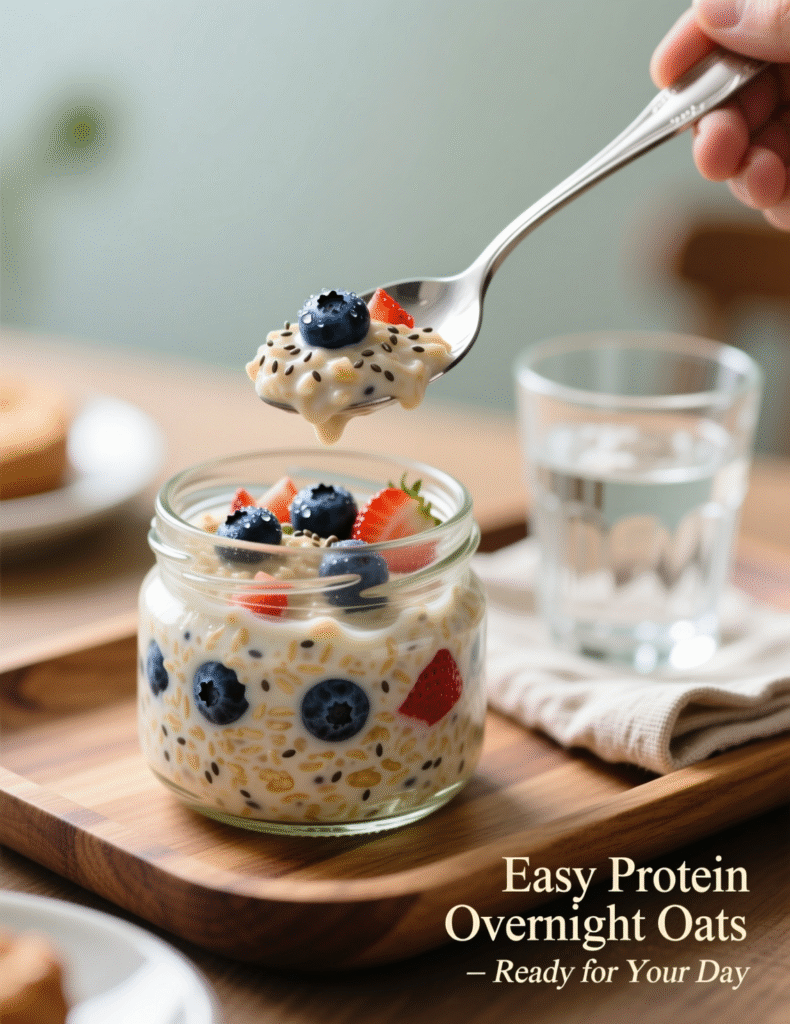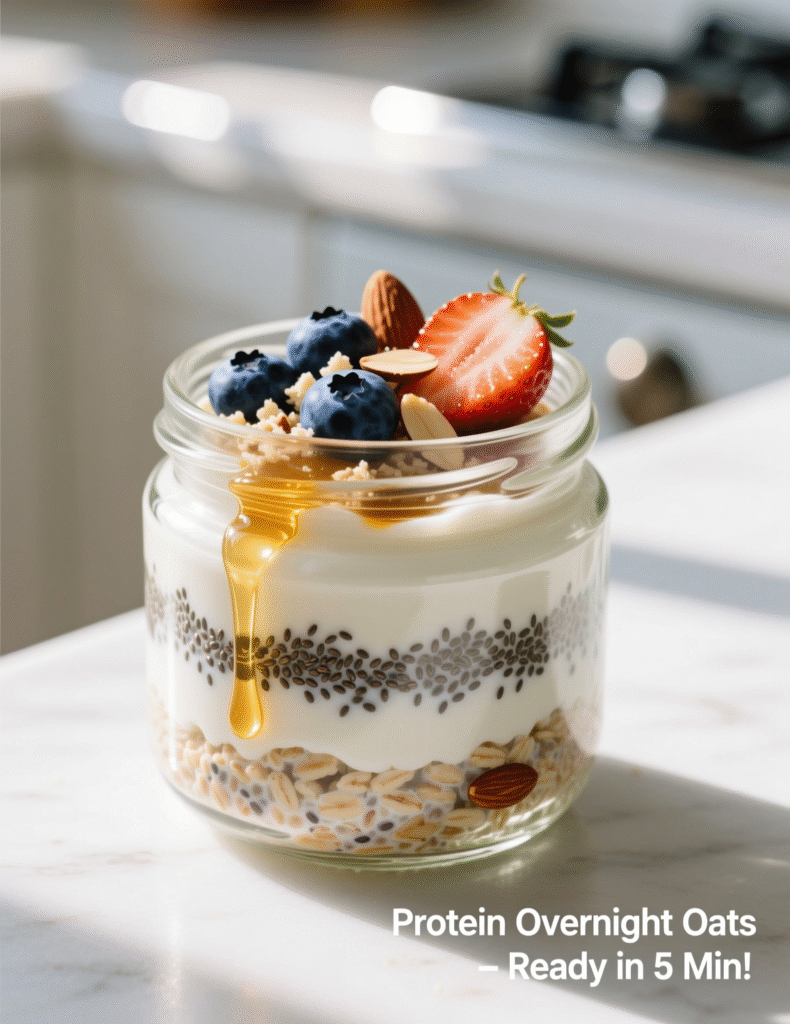Mornings are never long enough. The clock wins every time. That’s why recipes like protein overnight oats slide into people’s lives like a quiet miracle. They take five minutes the night before, and suddenly breakfast is solved. No stove, no frying pan, no dishes piled up. Just a chilled jar waiting in the fridge. The purpose of this guide is simple—teach you how to make overnight oats that actually fuel your body with enough protein to last until lunch, without tasting like chalk or resembling soggy cardboard.
Why Overnight Oats Work So Well
Overnight oats thrive on a principle chefs love—hydration over time. Raw oats steep in liquid for hours, softening into a creamy texture that rivals slow-cooked porridge. Except no heat is required. The starches swell, the fibers relax, and flavors marry overnight. Professionals know that texture is everything. Overnight oats done poorly feel like paste. Done right, they’re a balanced harmony of chew and creaminess.
The big kicker here is protein. Oats alone carry around 5 grams per half cup, not nearly enough for a sustained breakfast. But with careful layering—Greek yogurt, whey protein, milk, seeds—you can double or triple that amount. Studies show protein-rich breakfasts help with satiety and energy balance through the day (American Journal of Clinical Nutrition, 2015). In a kitchen environment where efficiency meets nutrition, this is gold.
The Core Recipe
Let’s build the base. This is the foundation for countless variations.
Ingredients for 1 serving (scale easily to 4-5 jars for a week):
- ½ cup rolled oats
- ¾ cup milk of choice (dairy, soy, oat, almond)
- ½ cup Greek yogurt (adds creaminess + protein)
- 1 scoop vanilla protein powder (about 20–25g protein)
- 1 tbsp chia seeds or flaxseed
- 1 tsp honey or maple syrup (optional, for sweetness)
- Pinch of salt (yes, always)
Method:
- In a mason jar or container, stir together oats, milk, yogurt, protein powder, and seeds.
- Mix well—clumps of protein powder ruin mornings. Use a whisk or even shake the jar.
- Sweeten lightly if desired.
- Cover and refrigerate overnight, at least 6 hours.
- In the morning, stir, top with fruit, nuts, or nut butter.
That’s it. Breakfast in 5 minutes of prep, with roughly 30–35 grams of protein, depending on your ingredients.
The Science of Getting Protein Right
Professionals will tell you protein powders don’t all play fair. Whey isolate dissolves cleanly, giving a smooth finish. Casein thickens overnight, almost like pudding. Plant-based powders—pea, hemp, soy—can taste earthy or gritty, requiring more liquid or a dash of nut butter to smooth the mouthfeel. If texture isn’t managed, customers (or family) will notice.
Greek yogurt is another anchor here. A single cup can hold 18–20 grams of protein. Layering yogurt with oats stabilizes the mix and prevents separation. Without it, overnight oats can look watery in the morning, which turns people off. This is especially critical if you’re prepping for food service or meal delivery. Presentation matters, even in a fridge jar.

Common Mistakes People Make
The most frequent error? Too much liquid. Overnight oats should be creamy, not soupy. Oats expand by about 30% overnight, so precision matters. Another mistake is skipping salt. It may seem odd in a sweet breakfast, but just a pinch lifts the entire flavor profile.
Another pitfall is overloading toppings in advance. Bananas, for example, turn brown and mushy overnight. They belong at the last second, just before eating. Berries and apples hold up better if you insist on prepping everything at once.
Lastly, poor mixing. Protein powder clumps stay chalky. I’ve seen chefs strain overnight oats because of this. The solution is simple—whisk thoroughly or shake the jar vigorously before refrigerating.
Variations for Different Lifestyles
Every eater has a different goal. A professional recipe developer knows adaptability is king.
For Weight Loss
Use unsweetened almond milk, plain nonfat Greek yogurt, and a lean protein powder. Top with fresh berries and a teaspoon of nut butter. Keeps calories low but satiety high.
For Athletes
Go heavy. Whole milk, full-fat yogurt, and a whey-casein blend powder for slower digestion. Add oats plus a spoonful of peanut butter or almond butter. Top with banana slices for quick carbs before training.
Vegan-Friendly
Use soy or pea protein, oat milk, and coconut yogurt. Hemp seeds add both protein and omega-3s. Maple syrup or agave can sweeten without dairy.
Kid-Friendly
Skip protein powder if needed, but keep the yogurt. Add a drizzle of honey and top with diced apples, cinnamon, or mini chocolate chips. Children accept oats easier when sweetness is familiar.
A Nutritionist’s Perspective
Protein is essential, but the fiber content of oats shouldn’t be overlooked. A single serving provides 4–5 grams of dietary fiber, key for digestive health and cholesterol control. Combine that with chia seeds or flax, and you’re boosting soluble fiber significantly. According to the USDA, adults need 25–38 grams of fiber per day, yet most consume less than half. Overnight oats nudge that number upward without effort.
Also worth noting: timing. Eating a protein-rich meal within two hours of waking helps stabilize blood sugar and improve cognitive performance throughout the morning. This is critical for professionals, students, and athletes alike. A jar of protein overnight oats meets this nutritional requirement without fuss.
Professional Kitchen Application
In a café or meal-prep setting, overnight oats scale beautifully. Large trays can be prepped, portioned into jars, and stored for up to five days under refrigeration. The margin is high—rolled oats cost pennies per serving, while perceived value to customers is much greater. Add toppings like seasonal fruit, nut butters, or cacao nibs, and you can charge a premium price point.
But scaling requires consistency. Weigh oats and protein powder, don’t scoop. Liquid ratios must remain exact. A 1:1.5 ratio of oats to liquid usually holds, but adding yogurt changes the balance. Testing is key.
Addressing Misconceptions
Some believe overnight oats lose nutrients overnight. That’s false. Cold hydration doesn’t reduce vitamin or mineral content. If anything, it may improve digestibility, since phytic acid levels drop as oats soak, freeing up minerals like iron and zinc. Another misconception is that oats are too carb-heavy. But paired with protein and fat, their glycemic impact reduces. This balance keeps blood sugar steady.
Others worry protein powder isn’t “natural.” That depends entirely on the brand and source. Many protein powders undergo simple filtration and drying processes. Whey protein isolate, for example, is essentially dried dairy proteins with minimal additives. As long as you choose clean labels, it’s not much different than eating strained yogurt.
Emerging Trends in Overnight Oats
The market is growing. According to Allied Market Research, the global overnight oats market is expected to expand at over 6% CAGR through 2030. Food companies are experimenting with flavors like matcha, pumpkin spice, and mocha. Consumers demand convenience, but also novelty.
There’s also a surge in functional add-ins. Collagen peptides, probiotics from yogurt, or adaptogens like maca are entering the overnight oats scene. These additions move oats from simple breakfast to functional wellness food. Professionals in food development should take note—overnight oats are no longer just oats, milk, and fruit. They’re vehicles for targeted nutrition.

Final Tips for Busy People
Prep 4–5 jars at once. Rotate flavors to avoid boredom—blueberry almond one day, peanut butter banana the next, chocolate cherry another. Keep toppings separate until morning if freshness is a priority.
Experiment with texture. Add more chia seeds for a thicker pudding-like finish. Stir in grated apple or carrot for natural sweetness. Don’t shy away from savory versions—oats, Greek yogurt, shredded cucumber, herbs, and a sprinkle of feta make a surprising protein-rich breakfast that breaks the monotony of sweet starts.
Conclusion
Protein overnight oats are not just a shortcut breakfast. They’re a smart layering of nutrition, convenience, and culinary science. The oats hydrate, the protein stabilizes energy, the yogurt enriches texture, and the fridge does the heavy lifting while you sleep. Whether you’re a busy professional rushing out the door, a chef scaling recipes for a café, or simply someone tired of skipping breakfast, this recipe adapts to you.
The key takeaways: precision in liquid-to-oat ratios, thoughtful protein choice, and timing of toppings. Respect those, and overnight oats become not just edible but crave-worthy. Action step? Tonight, take 5 minutes, prep a jar, and meet your best breakfast tomorrow morning before the clock even thinks of rushing you.
FAQs
What are protein overnight oats?
They’re oats soaked overnight with protein sources like yogurt, milk, or protein powder for a quick, balanced breakfast.
How much protein is in one serving?
Usually around 30–35 grams, depending on the protein powder and yogurt used.
Can I make overnight oats without protein powder?
Yes, you can use Greek yogurt, cottage cheese, or chia seeds as natural protein boosters.
How long do overnight oats last in the fridge?
They keep well for 4–5 days if stored in sealed containers.
Are overnight oats eaten cold or warm?
Traditionally cold, but you can warm them briefly in the microwave if preferred.
Do overnight oats lose nutrients overnight?
No, soaking actually makes some nutrients easier to absorb.
Can I prepare multiple servings at once?
Yes, batch prep 4–5 jars at a time for the week ahead.
What type of oats work best?
Rolled oats hydrate perfectly, while steel-cut oats stay too firm and instant oats turn mushy.
Are overnight oats good for weight loss?
Yes, when portioned right with lean protein and limited sweeteners, they support satiety and calorie control.
Can I make them dairy-free?
Absolutely, just swap dairy yogurt and milk for plant-based versions like soy or almond.

Marie Smith is a passionate recipe blogger, sharing easy, delicious, and creative culinary ideas that inspire home cooks to elevate everyday meals with flavor and simplicity.
